Day 3 of a four day Autumn Tour today. It was a lovely, bright and at times sunny day, but with a nagging, blustery SW wind which didn’t ease until later in the afternoon.
Our first destination for the morning was Holkham. As we parked at the top of Lady Anne’s Drive, we could hear Pink-footed Geese calling. We turned to see skein after skein of them flying in from the east, presumably coming in from the overnight roost on the flats north of Wells. They flew in over our heads or round over the pines and dropped down onto the grazing marshes to the west of us. It is an amazing sight and sound, watching and listening to the Pink-footed Geese flying in here, a real sound of Norfolk in the winter.
 Pink-footed Geese – flying in to the grazing marshes this morning
Pink-footed Geese – flying in to the grazing marshes this morning
It was noticeably breezy already when we got out of the car, but as we turned to walk along the track to the west, on the inland side of the pines, we found ourselves in the shelter of the trees and it didn’t seem so bad. It was fairly quiet along here nonetheless, but we did find a pair of Goldcrests feeding in the edge of the pines above us. A Sparrowhawk flew out of the trees and hung in the wind above us for a few seconds.
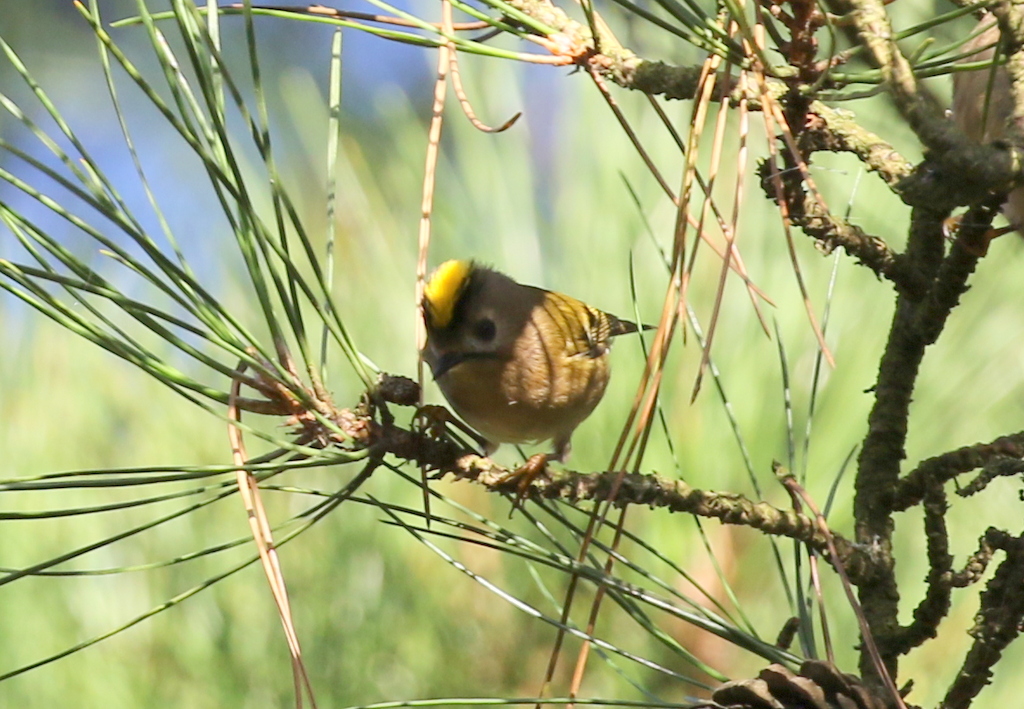 Goldcrest – feeding in the pines above the path
Goldcrest – feeding in the pines above the path
However, once we got to Salts Hole, we found ourselves out in the wind again. There were lots of Mallard on the pool today, but looking carefully, we could see at least four Little Grebes too. A couple of them were diving out in the centre, but two were stationary at the back long enough for us to get them in the scope.
A Kingfisher zipped across over the grass at the back, but didn’t stop and disappeared again behind the trees. Two Grey Wagtails were more obliging, circling over the pool before landing on the mud at the back of the pool where we could get a good look at them. There have been a lot of Grey Wagtails moving along the coast in the last week or so, so these were probably migrants just stopping off on their way somewhere.
There were lots of Jays in the trees, but all we saw at first was the back end of them as they flew away in front of us. When we got to the gate just before Washington Hide, one finally landed in full view, hopping around out in the grass, so we could get a more complete view of it.
It was while we were standing at the gate that we heard Bearded Tits calling and looked back along the path to see several flying through the trees. Even more bizarrely, they then landed in the trees, something we have never seen before. Unfortunately, we couldn’t see them where they landed, but we could hear them calling to each other, half way up through the branches on the other side of the path. They stayed there for a minute or so, before first one and then the others all flew on and dropped down into the reeds in front of Washington Hide, a much more appropriate location for Bearded Tits.
As we walked up the boardwalk towards Washington Hide, we could see a large white shape at the back of the pool in front, a Great White Egret. It was immediately clear just how big it was – much bigger than a Little Egret. We stopped to have a look at it through the scope, admiring its long, dagger-like yellow bill. Then it walked back into the far corner of the pool out of view.
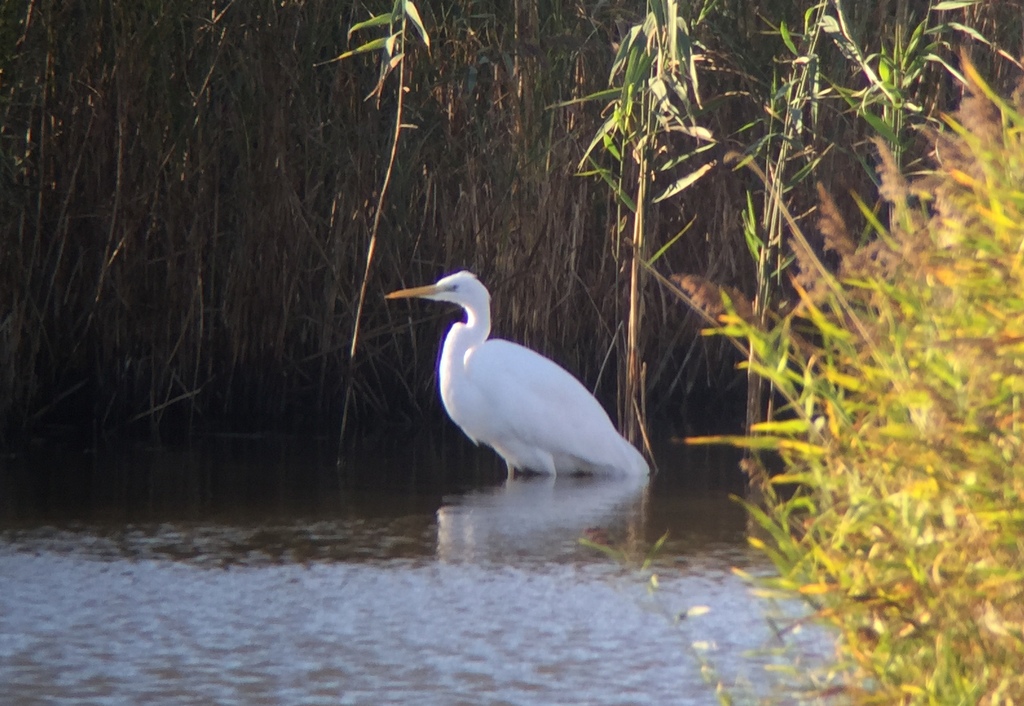 Great White Egret – on the pool in front of Washington Hide again
Great White Egret – on the pool in front of Washington Hide again
There were Long-tailed Tits calling from the trees behind the hide, but they were well hidden, tucked deep into the trees out of the wind. There was nothing in the sycamores by the boardwalk, so we went into the hide to see what we could see from there. There were lots of ducks on the pool, mostly Wigeon and Teal.
A Marsh Harrier was the first raptor we picked up from here, flying low across over the grazing marsh. A Common Buzzard appeared too and landed on a nearby bush. There has been an Osprey lingering around Holkham Park for a few days now, and scanning over the trees in the distance we spotted it circling over where the lake would be. Three Red Kites circled up out of the trees in the Park too, but whereas the Osprey dropped back down out of view, the Red Kites circled lazily across the grazing marshes to the pines.
We decided to have a quick look out at the beach, as much to admire the view as anything. It was a bit more sheltered on the north side of the pines, but it looked rather windy out to sea. There were lots of gulls feeding distantly offshore and in with them we could see several Gannets. The Gannets were fishing, circling round and plunging headfirst into the water.
Back on the south side of the pines, we continued on west along the main path. The trees around Meals House were being blown round in the wind, and were devoid of birds today, so we decided to make straight for the west end where we hoped there might perhaps be a lingering Yellow-browed Warbler. Unusually, we didn’t encounter a single tit flock on our way there – they all seemed to be hiding deep in the pines today. We did hear an occasional Goldcrest or Coal Tit calling.
The sallows at the west end of the trees at least held a couple of Goldcrests, but there was nothing in the sycamores on the edge of the dunes. It was just too windy today. A Red Kite was hanging in the air out over the dunes. After a quick rest and a careful listen for any signs of life, we decided to start making our way back.
 Long-tailed Tit – we finally found a tit flock on our way back
Long-tailed Tit – we finally found a tit flock on our way back
When we got back to the crosstracks, we finally heard Long-tailed Tits calling. We ducked into the trees and found them in a sheltered glade. There were other tits and Goldcrests with them, and we also got a good look at a Treecreeper too. They made their way back out onto the sunny edge of the trees so we followed them. We finally got good views of all the main tit flock species, but we couldn’t find anything else with them while they were in view. They didn’t hang around, and after a quick circuit round a few trees, they disappeared back into the pines again.
As we continued on our way back to Lady Anne’s Drive, we had great views of a Red Kite which flew towards us over the track and hung in the wind just above us, before drifting back out towards the grazing marshes.
 Red Kite – hung in the wind above us on our way back
Red Kite – hung in the wind above us on our way back
While we ate our lunch back at the picnic tables at Lady Anne’s Drive, listening to the calls of all the geese coming and going, we spotted another Great White Egret flying over the grazing marshes. It dropped down on the edge of a ditch, attracting the attention of one of the local Grey Herons, which chased in after it. It was great to see the two species close together, the Great White Egret being similar in size.
After lunch, we headed over to Holkham Park. We had been told there was a pair of Firecrests earlier, in the holm oaks along the drive, but we couldn’t find them at first. While we were looking and listening for them, we looked across to one of the houses on the edge of the park and noticed a lot of activity in a yew tree in the garden. Getting the scope on it, we could see a couple of Redwings and a Blackcap eating the berries. There were lots of tits coming and going too, and we figured we could get closer to the yew tree from the paths in the Park.
We made our way round there and stood by the yew tree, watching the comings and goings. A Nuthatch made several feeding visits in from the trees nearby and we stopped to watch a couple of Goldcrests in the yew too. At that point, we heard a sharper call behind us and turned to see a Firecrest in the top of some flowering ivy. It flew across into the yew and we had great close view of Goldcrest and Firecrest flicking around together.
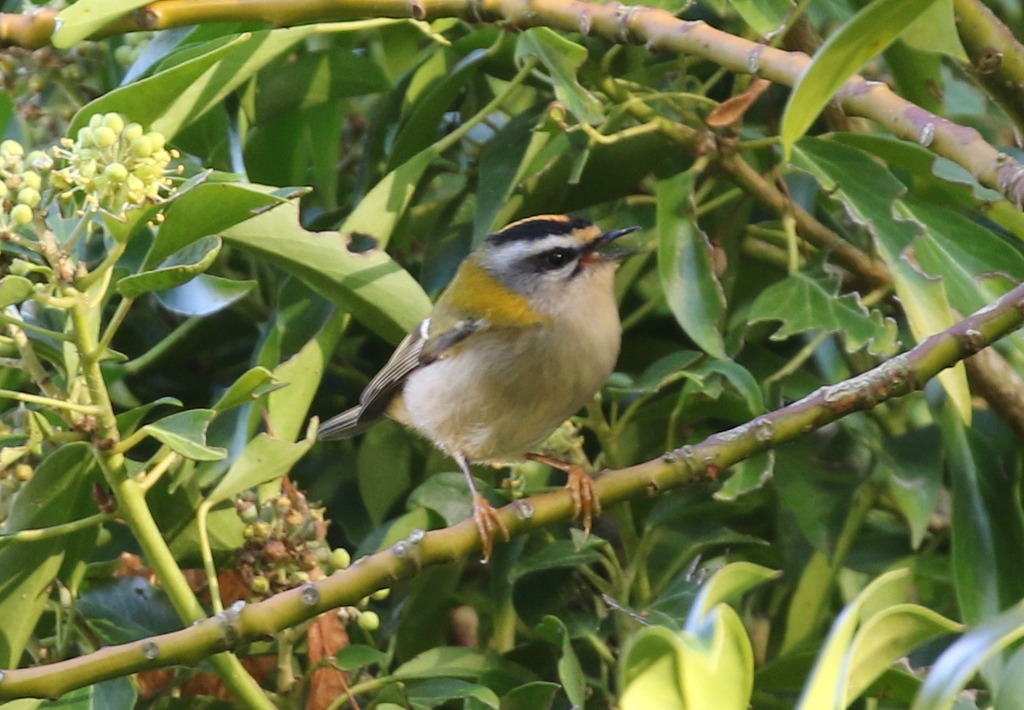 Firecrest – we finally found the pair on the edge of the Park
Firecrest – we finally found the pair on the edge of the Park
The Firecrest was alert, with crown feathers raised and spread, revealing a bright fiery orange crest, which meant it was a male. It disappeared deeper into the yew, but a short while later reappeared in a nearby holm oak. This time it had been joined by a second Firecrest, probably a female, but without their crown feathers raised now it was hard to tell.
There were lots of Fallow Deer under the trees, a little group of which ran across the path in front of us. After stopping to admire the Monument and the view across to Holkham Hall, we continued on down to the lake. It didn’t take us long to find the Osprey. It was in the top of one of its favourite trees over the far side of the water, perched on a dead branch. We got it in the scope and could see it was in the process of devouring a small fish – just the tail was left!
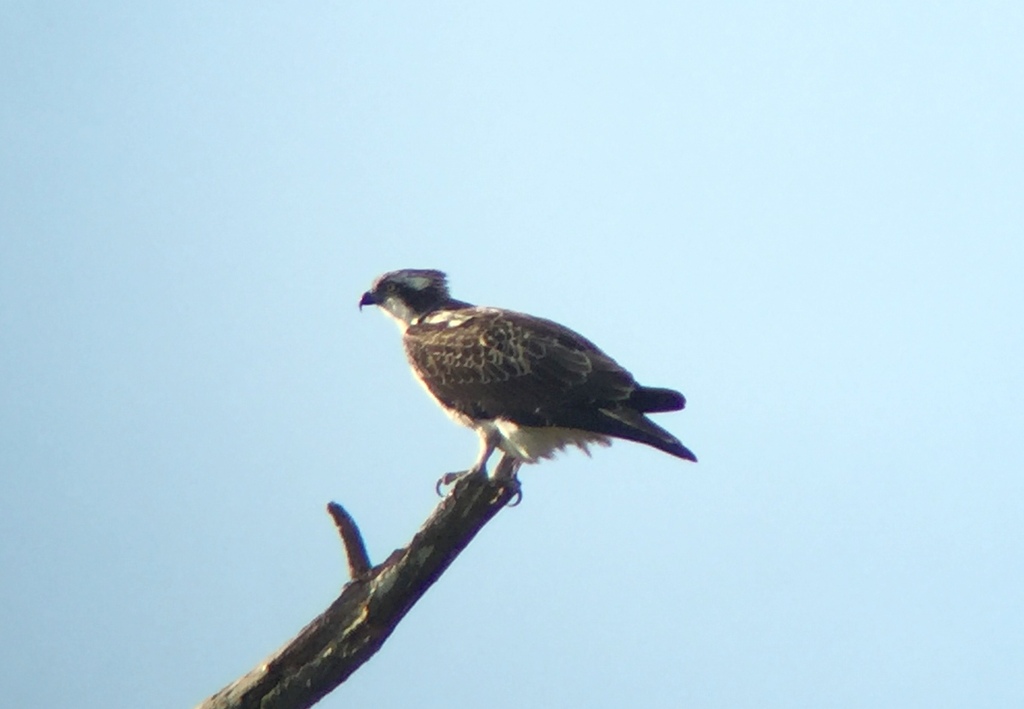 Osprey – perched in the top of one of the trees by the lake
Osprey – perched in the top of one of the trees by the lake
We watched the Osprey for a while, but it seemed fairly settled where it was and, having just eaten, we presumed it wouldn’t be fishing again for a bit. We continued on round to the north end of the lake. There were a few ducks around the edges and several Tufted Duck asleep. It wasn’t until we got to the far end that we finally found a small raft of Common Pochard, a new species for the trip list.
A Kingfisher zipped past low over the water and disappeared behind the trees. Several Great Crested Grebes were out on the lake, a mixture of moulting adults and juveniles. Under the overhanging branches on the island at the north end, we found a couple of Little Grebes, an adult and a not quite yet fully grown juveniles. The juvenile was swimming round the adult, begging to be fed, but the adult Little Grebe looked distinctly disinterested.
 Great Crested Grebe – one of several on the lake
Great Crested Grebe – one of several on the lake
As we made our way back along the side of the lake, we could see the Osprey was still in position at the top of its tree. A Great White Egret had now appeared down on the far shore too, perhaps our third of the day! This one was much nearer, and we got a great look at it through the scope.
 Great White Egret – on the edge of the lake
Great White Egret – on the edge of the lake
While we were watching the Great White Egret and taking some photos, we noticed someone walking along the far bank. They stopped, but not soon enough to prevent them flushing the egret. We watched as it flew down the lake and landed again further along. But when we looked up into the trees, we noticed that the Osprey had flushed too.
Figuring that it might have gone fishing again, we made our way slowly along the bank towards the south end of the lake. Unfortunately, we had not even got out of the trees when we saw two people ahead of us pointing cameras at the sky right above their heads. The Osprey then appeared from behind the trees but it was always flying away from us, into the sun. It had already caught another fish and was carrying it off back to its favourite tree to eat it.
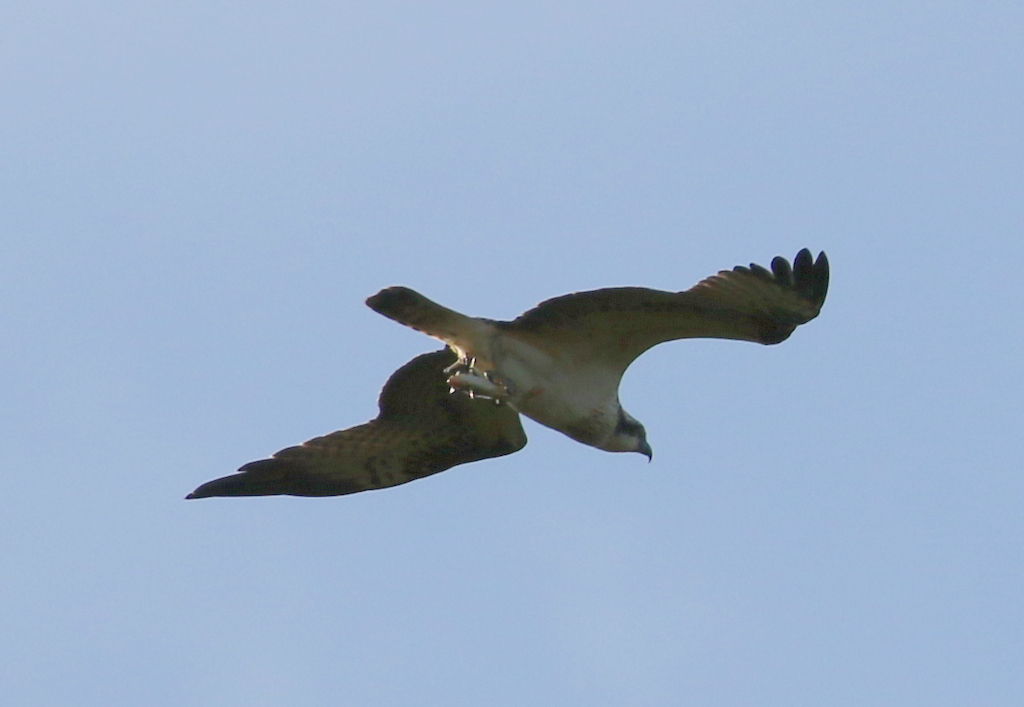 Osprey – heading back to its favourite perch with a fish
Osprey – heading back to its favourite perch with a fish
We made our way back up across the park. On the way, we stopped to admire the herd of Fallow Deer. Most of them had now gathered out in the open in the grass. We watched a particularly striking buck parading through the others. As we walked back through the trees, we found another buck vigorously rubbing its antlers against the fallen branch of a tree, presumably trying to clean off the last of its velvet, although it seems a little late for it still to be doing this.
 Fallow Deer – part of the herd in the deer park this afternoon
Fallow Deer – part of the herd in the deer park this afternoon
With everyone suitably tired out after the various walks today, we decided to head round to Stiffkey Greenway for the last hour of the day, where we could have a look out across the saltmarsh from the car park, without having to venture too far on foot. There were plenty of Little Egrets and Curlew out on the saltmarsh, plus several small groups of Brent Geese.
In the distance, we picked out a lone adult Peregrine which was perched out on the sand flats. There were no other raptors hunting here this afternoon though – it was perhaps still a bit early for birds to be coming in to roost.
A couple of Yellowhammers were in the hedge by the car park, so we went round to the sunny side to try to get a good look at them. We got them in the scope, before they flew off and dropped down into the field. We could hear Long-tailed Tits calling from the edge of Campsite Wood, so we wandered over for a look. The wind had dropped and the birds had come out onto the sunny side by the car park. There were Blue Tits, Great Tits and a couple of Goldcrests with them, and we found a Chiffchaff flycatching in the top of the hawthorns too. Then, as they moved off back into the trees, it was time for us to head off too.
















